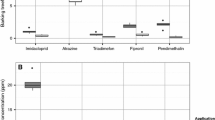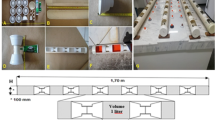Abstract
Amphibians in terrestrial environments obtain water through a highly vascularized pelvic patch of skin. Chemicals can also be exchanged across this patch. Atrazine (ATZ), a widespread herbicide, continues to be a concern among amphibian ecologists based on potential exposure and toxicity. Few studies have examined its impact on the terrestrial juvenile or adult stages of toads. In the current study, we asked the following questions: (1) Will juvenile American toads (Bufo americanus) avoid soils contaminated with ATZ? (2) Can they absorb ATZ across the pelvic patch? (3) If so, how is it distributed among the organs and eventually eliminated? We conducted a behavioral choice test between control soil and soil dosed with ecologically relevant concentrations of ATZ. In addition, we examined the uptake, distribution, and elimination of water dosed with 14C-labeled ATZ. Our data demonstrate that toads do not avoid ATZ-laden soils. ATZ crossed the pelvic patch rapidly and reached an apparent equilibrium within 5 h. The majority of the radiolabeled ATZ ended up in the intestines, whereas the greatest concentrations were observed in the gall bladder. Thus, exposure of adult life stages of amphibians through direct uptake of ATZ from soils and runoff water should be considered in risk evaluations.





Similar content being viewed by others
References
Allran JW, Karasov WH (2001) Effects of atrazine on embryos, larvae, and adults of anuran amphibians. Environ Toxicol Chem 20:769–775
Brand RM, Mueller C (2002) Transdermal penetration of atrazine, alachlor, and trifluralin: effect of formulation. Toxicol Sci 68:18–23
Carr JA, Gentles A, Smith EE, Goleman WL, Urquidi LJ, Thuett K et al (2003) Response of larval Xenopus laevis to atrazine: assessment of growth, metamorphosis, and gonadal and laryngeal morphology. Environ Toxicol Chem 22:396–405
Cassano G, Bellantuono V, Ardizzone C, Lippe C (2006) Atrazine increases the sodium absorption in frog (Rana esculenta) skin. Environ Toxicol Chem 25:509–513
Coady KK, Murphy MB, Villeneuve DL, Hecker M, Jones PD, Carr JA et al (2005) Effects of atrazine on metamorphosis, growth, laryngeal and gonadal development, aromatase activity, and sex steroid concentrations in Xenopus laevis. Ecotoxicol Environ Safe 62:160–173
Diamond JM (1962) The reabsorptive function of the gall-bladder. J Physiol 161:442–473
Edginton AN, Rouleau C (2005) Toxicokinetics of 14C-atrazine and its metabolites in stage-66 Xenopus laevis. Environ Sci Technol 39:8083–8089
Ghidey F, Alberts EE, Lerch RN (1997) Spatial and temporal variability of herbicides in claypan soil watershed. J Environ Qual 26:1555–1563
Gosner KL (1960) A simplified table for staging anuran embryos and larvae with notes on identification. Herpetologica 16:183–190
Guerry AD, Hunter ML Jr (2002) Amphibian distributions in a landscape of forests and agriculture: an examination of landscape composition and configuration. Conserv Biol 16:745–754
Hall RJ, Henry PFP (1992) Assessing effects of pesticides on amphibians and reptiles: status and needs. Herpetologica 1992:65–71
Hatch AC, Belden LK, Scheessele E, Blaustein AR (2001) Juvenile amphibians do not avoid potentially lethal levels of urea on soil substrate. Environ Toxicol Chem 20:2328–2335
Hayes TB, Collins A, Lee M, Mendoza M, Noriega N, Stuart AA et al (2002) Hermaphroditic, demasculinized frogs after exposure to the herbicide atrazine at low ecologically relevant doses. Proc Natl Acad Sci USA 99:5476–5480
Hayes T, Haston K, Tsui M, Hoang A, Haeffele C, Vonk A (2003) Atrazine induced hermaphrodism at 0.1 ppb in American leopard frogs (Rana pipiens): laboratory and field evidence. Environ Health Perspect 111:568–575
Hecker M, Giesy JP, Jones PD, Jooste AM, Carr JA, Solomon KR et al (2004) Plasma sex steroid concentrations and gonadal aromatase activities in African clawed frogs (Xenopus laevis) from South Africa. Environ Toxicol Chem 23:1996–2007
Hecker M, Kim WJ, Park JW, Murphy MB, Villeneuve D, Coady KK et al (2005) Plasma concentrations of estradiol and testosterone, gonadal aromatase activity and ultrastructure of the testis in Xenopus laevis exposed to estradiol or atrazine. Aquat Toxicol 72:383–396
Hillyard SD (1999) Behavioral, molecular and integrative mechanisms of amphibian osmoregulation. J Exp Zool 283:662–674
Hurlbert SH (1969) The breeding migrations and interhabitat wandering of the vermilion-spotted newt Notophthalmus viridescens (Rafinesque). Ecol Monogr 39:465–488
James SM, Little EE, Semlitsch RD (2004) Effects of multiple routes of cadmium exposure on the hibernation success of the American toad (Bufo americanus). Arch Environ Contam Toxicol 46:518–527
Marrero MB, Hillard SB (1985) Differences in cyclic AMP levels in epithelial cells from pelvic and pectoral regions of toad skin. Comp Biochem Physiol 82C:69–73
McClanahan LL Jr, Baldwin R (1969) Rate of water uptake through the integument of desert toad, Bufo puntatus. Comp Biochem Physiol 28C:381–389
Murphy MB, Hecker M, Coady KK, Tompsett AR, Jones PD, du Preez LH et al (2006) Atrazine concentrations, gonadal gross morphology and histology in ranid frogs collected in Michigan agricultural areas. Aquat Toxicol 76:230–245
Pechmann JHK, Semlitsch RD (1986) Diel activity patterns in the breeding migrations of winter-breeding anurans. Can J Zool 64:1116–1120
Preest MR, Pough FH (2003) Effects of body temperature and hydration state on organismal performance of toads, Bufo americanus. Physiol Biochem Zool 76:229–239
Rohr JR, Palmer BD (2005) Aquatic herbicide exposure increases salamander desiccation risk eight months later in a terrestrial environment. Environ Toxicol Chem 24:1253–1258
Ruibal R (1962) The adaptive value of bladder water in the toad, Bufo cognatus. Physiol Zool 35:218–223
Semlitsch RD (2008) Differentiating migration and dispersal processes for pond-breeding amphibians. J Wildl Manage 72:260–267
Semlitsch RD, Pechmann JHK (1985) Diel pattern of migratory activity for several species of pond-breeding salamanders. Copeia 1985:86–91
Storrs SI, Semlitsch RD (2008) Variation in somatic and ovarian development: predicting susceptibility of amphibians to estrogenic contaminants. Gen Comp Endocrinol 156:524–530
Sullivan PA, von Seckendorff Hoff K, Hillard SD (2000) Effects of anion substitution on hydration behavior and water uptake of the red-spotted toad, Bufo punctatus: is there an anion paradox in amphibian skin? Chem Senses 25:167–172
Todd BD, Winne CT (2006) Ontogenetic and interspecific variation in timing of movement and responses to climatic factors during migrations by pond-breeding amphibians. Can J Zool 84:715–722
Viborg AL, Hillard SD (2005) Cutaneous blood flow and water absorption by dehydrated toads. Physiol Biochem Zool 78:394–404
Willens S, Stoskopf MK, Baynes RE, Lewbart GA, Taylor SK, Kennedy-Stoskopf S (2006) Percutaneous malathion absorption by anuran skin in flow-through diffusion cells. Environ Toxicol Pharm 22:255–262
Acknowledgments
We thank D. Nicks for help with dosage calculations and experimental setup. Thanks to D. Hardesty for the drill. Thank you to V. Velez and J. Zajieck for help with the counter. Thanks to L. Sullivan, B. Williams, and two anonymous reviewers for comments on the manuscript. Disclaimer: Any mention of trade names does not constitute government endorsement.
Author information
Authors and Affiliations
Corresponding author
Rights and permissions
About this article
Cite this article
Storrs Méndez, S.I., Tillitt, D.E., Rittenhouse, T.A.G. et al. Behavioral Response and Kinetics of Terrestrial Atrazine Exposure in American Toads (Bufo americanus). Arch Environ Contam Toxicol 57, 590–597 (2009). https://doi.org/10.1007/s00244-009-9292-0
Received:
Accepted:
Published:
Issue Date:
DOI: https://doi.org/10.1007/s00244-009-9292-0




